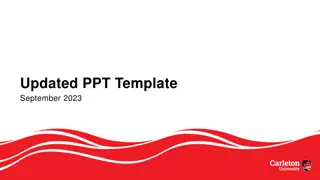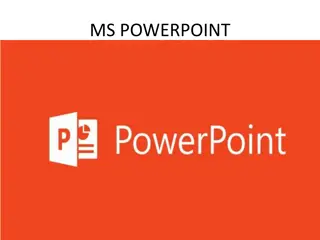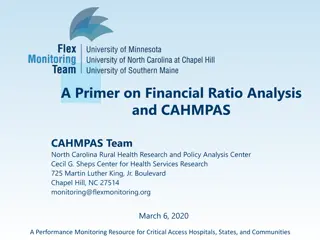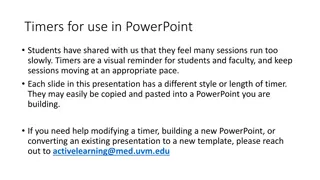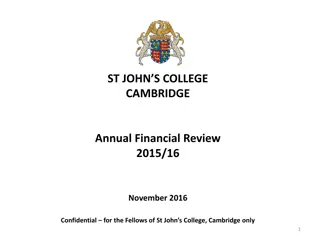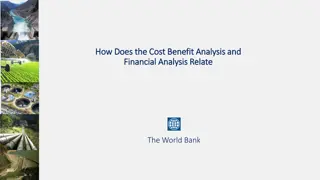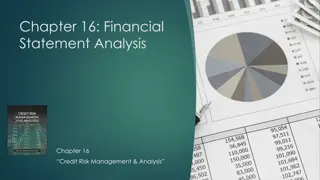
Understanding Financial Analysis for Business Improvement
Financial analysis is vital for businesses as it helps identify strengths, weaknesses, and potential problems, allowing managers to make informed decisions. Using tools like enterprise budgets, balance sheets, and income statements, financial analysis provides insights into liquidity, solvency, profitability, and financial efficiency.
Download Presentation

Please find below an Image/Link to download the presentation.
The content on the website is provided AS IS for your information and personal use only. It may not be sold, licensed, or shared on other websites without obtaining consent from the author. Download presentation by click this link. If you encounter any issues during the download, it is possible that the publisher has removed the file from their server.
E N D
Presentation Transcript
What is Financial Analysis? Using financial tools: Enterprise budgets Balance sheets Income statements To identify a business strengths and weaknesses Helps the manager improve the business
Why is it Necessary? Financial Analysis: Helps a manager take actions to improve the business Identifies potential problems before they occur Helps lenders analyze loan applications for strengths, weaknesses, and risks Helps the manager understand the business more fully
Types of Financial Analysis Ratio Analysis Use ratios and figures (net income, RAVC, etc.) Compare those ratios and figures to benchmarks Benchmarks are goals or standards Trend Analysis Look at changes in ratios and figures over time Are they improving or getting worse?
Main Areas of Analysis Liquidity Having enough current assets to cover your current liabilities Solvency Having enough total assets to cover your total liabilities Profitability Are we making money above our expenses? Financial Efficiency How well are we controlling our costs?
Liquidity Analysis Use the Balance Sheet Current Ratio is the main measure Current Ratio = Current Assets / Current Liabilities Like to see: A minimum ratio of 1.0 Greater than 2.0 is strong Interpretation: A Current Ratio of 2 means that you have $2 of current assets for every $1 of liabilities that are due within the next year (current liabilities)
Solvency Analysis Use the Balance Sheet Debt/Asset Ratio is the main measure Debt/Asset Ratio = Total Liabilities / Total Assets Like to see: Less than 40% for an existing business Less than 705 for a new or start-up business Decreasing over time The lower it is, the less risk you face
Solvency Analysis Interpretation: A Debt/Asset Ratio of 40% shows that you owe your lenders 40% of the value of your assets Or that you have paid for 60% of your assets Another way to look at it: Your lenders own 40% of your assets You own 60% of your assets
Profitability Analysis Use the Income Statement or Enterprise Budget Gross Margin Net income or Return Above Total Costs or Return Above Variable Costs Also need the Balance Sheet Main ratio is Rate of Return on Assets (ROA) ROA = (Net Income + Interest) / Total Assets
Profitability Analysis Like to see: ROA > 0% at a minimum ROA > interest rate (APR) on your loans ROA > 8% is strong Growing over time The higher, the more profitable your business Interpretation: An ROA of 10% means that you earned $0.10 of profit for every $1 of asset used in your business.
Financial Efficiency Analysis We re just focusing on cost control here Use the Income Statement Operating Expense/Receipt Ratio Op. Exp/Rec = (Total Exp. Int. Dep.) / Total Revenue Like to see: Less than 75% Interpretation: A ratio of 75% means that the business spends $0.75 in expenses to generate $1 of revenue
Summary Look at your ratings for each area Area Area Rating Rating Strength Strength or Weakness? or Weakness? For the Floral Shop example: Liquidity Strong/Okay ~ Strength Solvency Poor/Okay ~ Weakness Profitability Poor/Okay ~ Weakness Financial Efficiency Poor/Okay ~ Weakness
Summary Now the manager can see what areas need to be improved! Main ways to improve a business: Reduce the top 5 expenses Without hurting production Increase revenues More units produced & sold Different price Get rid of unneeded or un-used assets
Summary A manager must look at the financial and the production aspects of the business They are directly related!! Too often the financial aspects are ignored Lenders use this same analysis to review loan applications Managers should know their own strengths and weaknesses BEFORE meeting with the lender!


